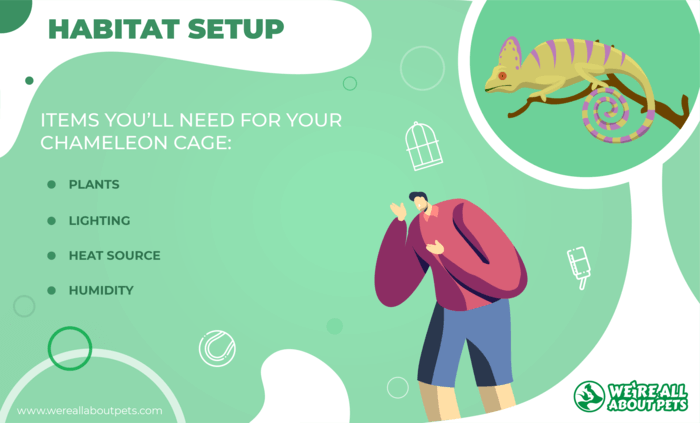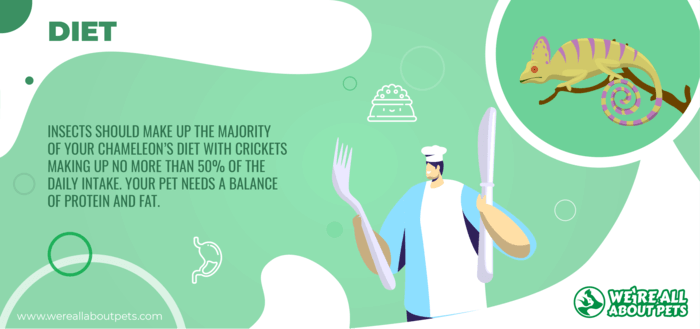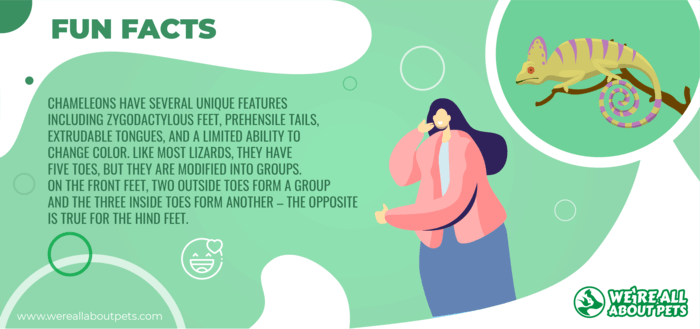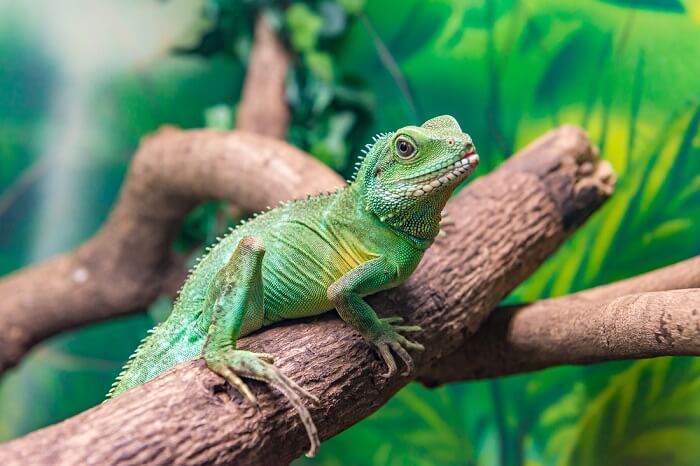How To Care For A Chameleon
This page contains affiliate links. We may earn money or products from the companies mentioned in this post through our independently chosen links, which earn us a commission. Learn More
General Stats:
- Pet Type: Reptile
- Size: up to 27 inches
- Diet: Omnivore
- Lifespan: 3 to 10 years
Chameleons are known for being able to change color, but many people know little else about them. What you may not know is that these reptiles make very interesting pets, but they can be a challenge to keep due to their specific requirements.
If you’re thinking about getting a chameleon as a pet, it’s a good idea to do some research to learn about the care requirements ahead of time. Only if you’re sure you can provide for your new pet’s needs should you go ahead with the process.
Here’s your essential chameleon care sheet with everything you need to know about these pets and how to prepare for owning one yourself.
Habitat Setup For Chameleons

Because chameleons are solitary animals, you only need to plan your enclosure for one. The best option is a terrarium because it keeps in heat and humidity but still allows for ventilation. Choose something that provides plenty of vertical space, at least 3x3x4 feet for an adult chameleon.
Here are some of the items you’ll need for your chameleon cage:
- Plants – Chameleons are arboreal reptiles, so they like to climb. Provide plenty of plants and branches for your pet to climb. Great live plants to try include pothos and ficus.
- Lighting – Like many reptiles, chameleons require both UVA and UVB light to utilize calcium properly. During the day, provide 10 to 12 hours of full-spectrum lighting and change the bulbs after 6 months to make sure your pet gets the full benefit.
- Heat Source – In addition to lighting your chameleon enclosure, you’ll need to maintain a temperature between 77°F – 87°F during the day and 65°F to 75°F at night. Ceramic heating elements are a great option, especially for a basking area.
- Humidity – You’ll need to install a drip system or misting system to keep your chameleon’s terrarium within the right humidity levels, around 50% to 70%. A dripper is usually inexpensive, but may not maintain the humidity well enough. A misting system is often required for chameleons.
In addition to choosing the right equipment for your chameleon’s enclosure, you should also think about where to put it. The best option is to put it somewhere you won’t have to worry about drafts or direct natural sunlight causing stress or temperature fluctuations. It shouldn’t be in a high-traffic area either.
Chameleon Diet

Chameleons will eat a wide variety of insects in the wild ranging from worms to grasshoppers. In captivity, your chameleon depends on you to provide for its nutritional needs, so variety is extremely important. You should gut-load your pet’s insects to optimize nutrition and dust them in a calcium supplement powder before feeding. Once a week add a multi-vitamin powder with Vitamin D3 and pre-formed vitamin A with the calcium.
Here are some quick facts about the ideal chameleon diet:
- Insects should make up the majority of your chameleon’s diet with crickets making up no more than 50% of the daily intake. Your pet needs a balance of protein and fat.
- Live insects are generally best for chameleons, freeze-dried insects provide less water content and can lead to dehydration.
- Provide your chameleon with small amounts of fresh food like small bits of fruit and chopped leafy greensseveral times a week to help ensure balanced nutrition.
- Consider feeding your chameleon from a bowl so the insects don’t escape and so your pet learns to recognize the bowl as a source of food. Make sure to place a branch near the bowl so your chameleon can access the food easily.
On top of your chameleon’s diet, be sure to provide unlimited access to clean water. Live insects and supplemental foods provide some hydration, but water should be available at all times. Chameleons rarely use bowls. You need to ensure that the misting system or dripper get the leaves dripping wet so you chameleon has access to that water.
Chameleon Veterinary Care

Proper care of your chameleon involves more than just providing a terrarium and a few insects – you also need to keep its health concerns in mind. Chameleons can be very tricky to keep. These reptiles are very prone to stress from excessive handling, loud noises, and changes in the environment.
It’s important to know what healthy chameleon behavior is and take your pet to the veterinarian at the first sign of illness. You’ll need to find an exotics vet or reptile vet, in most cases. You should take you chameleon to a veterinarian shortly after purchase for a health evaluation and a review of your care. They’re very difficult to keep, and this extra step can help prevent severe illness.
Here are some of the most common health problems in chameleons:
- Nutritional Secondary Hyperparathyroidism (formerly known as Metabolic Bone Disease)
- Egg binding
- Stomatitis (mouth rot)
- Weight loss
- Vitamin D deficiency
- Organ failure
- Parasites
- Infections (bacterial, fungal, viral)
In addition to being prone to a variety of health issues, chameleons can be very sensitive to household chemicals and toxins in the environment. Be very careful what cleaners you use around your chameleon and always wash your hand before handling it or anything in the enclosure.
Chameleon Fun Facts

- Chameleons have several unique features including zygodactylous feet, prehensile tails, extrudable tongues, and a limited ability to change color. Like most lizards, they have five toes, but they are modified into groups. On the front feet, two outside toes form a group and the three inside toes form another – the opposite is true for the hind feet.
- Like all reptiles, chameleons rely on their environment to regulate their body temperature. Maintaining a certain body temperature is required for feeding, digestion, and reproduction. Your chameleon’s preferences may vary depending on the species.
- For many years, exotic pets including chameleons were largely taken from the wild and sold as pets because there wasn’t enough knowledge to breed them. Today, most pet stores sell captive bred chameleons but it’s important to make sure before you buy.
- Chameleons come in a wide range of color and their skin changes color in response to emotion as well as changes in light, temperature, and humidity. Color is also an important aspect of communication for chameleons with brighter colors being exhibited by dominant males and by females to indicate they are pregnant.
- Their vision extends into the UV range. Many of the bones, especially around their heads, are shallow and will pick up UVA through the thin skin. Other chameleons see unique patterns in the UVA spectrum.
- Though there are over 200 species of chameleon, about 44% of them live in Madagascar. This has led scientists to wonder whether the chameleon family evolved on the island. Modern analysis, however, suggests that mainland Africa is a more likely origin point.
- Unlike many reptiles, female chameleons lay eggs even when they do not have a mate. Chameleons start laying eggs as early as 6 months old and, once mated, can retain sperm for up to 120 days. Unless the eggs have been fertilized, however, they will not hatch. Some species of chameleons bear live young in stead of eggs.
If you’re looking for a unique pet that will keep you intrigued, the chameleon might be a good choice. Keep in mind, however, these are not for beginners. They have specific and difficult care requirements. Care for other lizards first, and once you’ve learned to care for them well, then consider a chameleon.
Being a pet owner is a big responsibility, but especially for chameleons. Unless you’re able to provide for your new pet’s needs completely, consider another option.
Frequently Asked Questions
How long do chameleons live?
The average lifespan for a pet chameleon is 3 to 10 years, depending on the species and the quality of care.
How much do chameleons cost?
The cost to keep a pet chameleon varies greatly and it is one of the more expensive reptiles to keep. Depending which species of chameleon you choose, you could spend as little as $40 or as much as $500 on the reptile alone. Additional costs for the terrarium and necessary equipment such as a heat source, misting system, and lighting can run anywhere from $200 to over $500.
How big do chameleons get?
Pet chameleon size varies depending on the species of chameleon. The three most popular chameleon species include the veiled chameleon, Jackson’s chameleon, and the panther chameleon. The largest is the panther chameleon, growing up to 20 inches in length. The veiled chameleon is similar in size, growing up to 18 inches in length. Jackson’s chameleons stay smaller, usually growing to about 9 to 13 inches.
What do chameleons eat?
Though the chameleon is technically an omnivore, they follow more of an insectivorous diet. Chameleons will feed on a variety of insects including mealworms, crickets, waxworms, roaches, and more. They will also eat some fresh fruits and veggies and should be given calcium and vitamin supplements to prevent nutritional issues like metabolic bone disease.
Are chameleons good pets?
Chameleons definitely make unique and interesting pets, but they are far from the easiest pets to keep. If you’re an experienced reptile owner, you may already have some knowledge that will adapt to chameleon care. For beginner reptile enthusiasts, however, the chameleon is a big challenge.
Are chameleons messy?
Generally speaking, chameleons are not messy pets. They require a humid arboreal environment which comes with its own challenges, but the reptiles themselves aren’t particularly messy.
Where do chameleons come from?
Chameleons (family Chamaeleonidae) are a family of old world lizards containing just over 200 species. They can be found in warm habitats ranging from desert to rainforest throughout African countries like Yemen, Saudi Arabia, and Madagascar into southern Europe and Asia.
Do chameleons bite?
Chameleons are very solitary animals, so they can be a little defensive. Though chameleons can be tamed with regular handling, unwanted handling or improper handling may lead to hissing and biting. Though a chameleon’s bite isn’t toxic to humans, it can be quite painful.
Do chameleons sleep?
Chameleons sleep just like any other animal, though they may not follow a specific pattern. These reptiles are not strictly diurnal, but they do tend to sleep at night. Chameleons will sleep perched on a branch and may keep both eyes partially open or one eye completely open while sleeping.
How long are chameleons pregnant for?
Chameleon species can be either oviparous or ovoviviparous. Oviparous species lay eggs about 3 to 6 weeks after mating and will incubate the clutch for 4 to 12 months before hatching. They may lay eggs even if there is no male present. Ovoviviparous species, like Jackson’s chameleons, have a gestation period lasting 5 to 7 months after which the hatchlings are born inside a yolk sac.









